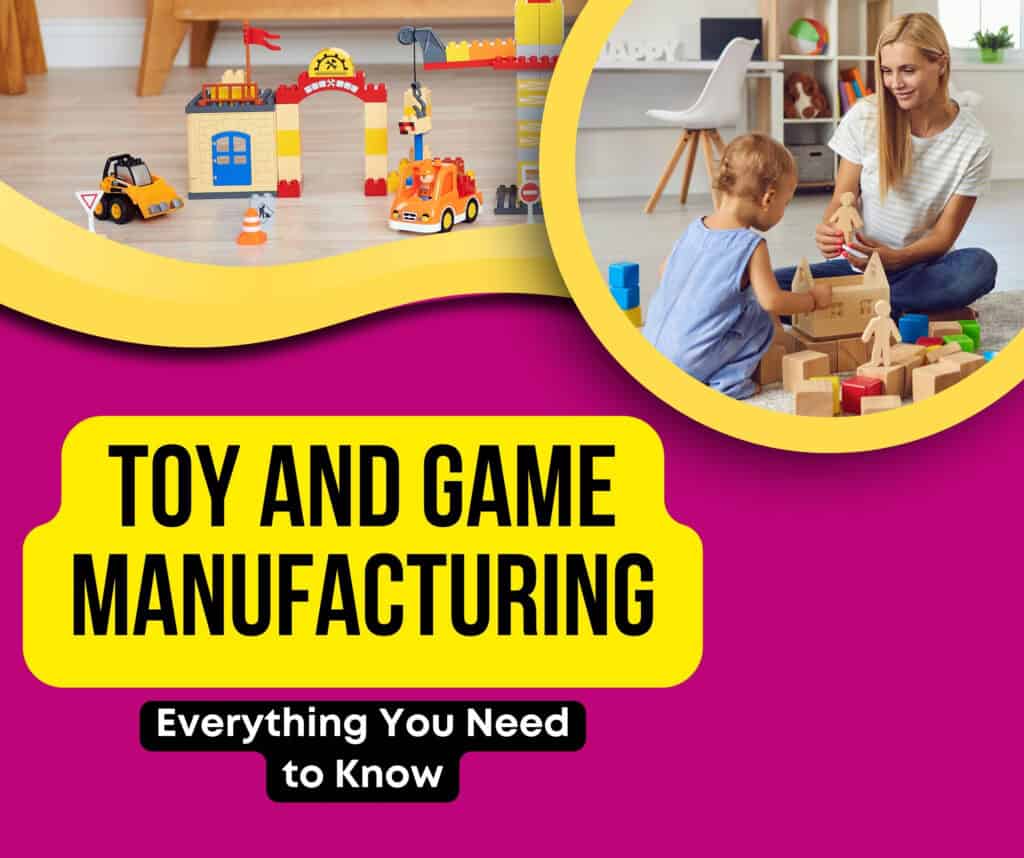The toy and game manufacturing industry is a vibrant sector that plays a crucial role in shaping childhood experiences and fostering creativity. This industry encompasses the design, production, and marketing of a wide array of products, including traditional toys, board games, and modern electronic games. From iconic action figures and educational toys to immersive video games and mobile applications, the diversity within this sector caters to a broad audience, from toddlers to adults. As a multi-billion dollar industry, toy and game manufacturing not only provides entertainment but also contributes significantly to economic growth and job creation worldwide.
The global toy market was valued at approximately $90 billion in 2021 and is expected to continue growing, driven by increasing disposable income, the rise of e-commerce, and innovative product offerings. This growth highlights the industry’s adaptability and resilience, particularly in the face of challenges such as global supply chain disruptions and changing consumer behaviors.
Several key trends are shaping the future of toy and game manufacturing:
- Sustainability: As environmental concerns become more prominent, manufacturers are increasingly prioritizing sustainable practices. This includes the use of eco-friendly materials, such as biodegradable plastics and recycled components, as well as adopting energy-efficient production processes. Consumers are now more inclined to support brands that demonstrate a commitment to sustainability, prompting manufacturers to innovate in this area.
- Technology Integration: The incorporation of technology in toys and games is transforming the way children play and learn. Smart toys equipped with artificial intelligence, interactive features, and connectivity to apps are gaining popularity. Additionally, the rise of augmented reality (AR) and virtual reality (VR) experiences is redefining gameplay, creating immersive environments that enhance engagement and learning.
- Changing Consumer Preferences: Modern consumers are increasingly seeking toys and games that offer educational value, promote inclusivity, and align with their values. There is a growing demand for products that encourage STEM (science, technology, engineering, and mathematics) learning, as well as those that reflect diverse cultures and experiences. This shift is influencing manufacturers to diversify their offerings and create products that resonate with today’s socially conscious consumers.
Every success story starts with a decision. Click here to start yours now!
Try Wealthy Affiliate (For Free).
What is Toy and Game Manufacturing?
Toy and game manufacturing refers to the entire process of designing, producing, and distributing products intended for play and entertainment. This industry encompasses a wide array of products, including traditional toys, board games, and modern electronic games. It involves various stages of development, from the initial concept to mass production, and plays a significant role in shaping childhood experiences and influencing learning through play.
Definition of Toy and Game Manufacturing
At its core, toy and game manufacturing is the systematic approach to creating products that engage and entertain consumers, particularly children. It combines creativity, engineering, and market research to develop items that not only provide enjoyment but also contribute to skill development and cognitive growth. The manufacturing process typically involves the following key phases:
- Concept Development: This is the brainstorming stage where ideas are generated based on market trends, consumer needs, and innovative designs. Manufacturers conduct thorough research to understand what products resonate with their target audience.
- Design and Prototyping: Once a concept is approved, designers create detailed specifications, often using computer-aided design (CAD) software. Prototypes are then built to test functionality, safety, and aesthetic appeal before proceeding to mass production.
- Manufacturing: This stage includes the actual production of toys and games. Depending on the type of product, manufacturing can involve various methods such as injection molding, assembly line production, or handcrafting for specialized items.
- Quality Control and Testing: Ensuring the safety and quality of toys and games is paramount. Manufacturers conduct rigorous testing to comply with safety regulations and industry standards, which may include checking for toxic materials, choking hazards, and durability.
- Marketing and Distribution: After production, products are marketed to retailers and consumers through advertising campaigns, trade shows, and online platforms. Efficient distribution channels are established to ensure products reach stores and consumers in a timely manner.
Scope of Toy and Game Manufacturing
The scope of toy and game manufacturing is extensive, covering a wide range of products and market segments. Here are some key areas within this industry:
- Traditional Toys: These include items such as dolls, action figures, building blocks, and plush toys. Traditional toys often emphasize imaginative play and creativity, encouraging children to develop social and cognitive skills.
- Board Games: Board games have seen a resurgence in popularity in recent years, appealing to families and adult gamers alike. The manufacturing process involves designing game mechanics, creating visually appealing boards and pieces, and ensuring a balanced gameplay experience.
- Video Games: This sector has rapidly evolved with the advent of technology. Toy and game manufacturers often collaborate with software developers to create interactive gaming experiences. This includes console games, mobile applications, and online gaming platforms, all of which require significant investment in technology and talent.
- Educational Toys: These products focus on learning and development, combining fun with educational content. Manufacturers design toys that teach concepts like math, language, science, and social skills, often incorporating technology to enhance the learning experience.
- Smart Toys: With the rise of technology, smart toys that integrate artificial intelligence (AI) and connectivity features are gaining popularity. These toys can interact with users, respond to voice commands, and even adapt their behavior based on play patterns, creating a more immersive and engaging experience.
Overview of Major Product Categories
- Action Figures and Dolls: These iconic toys often represent characters from movies, television shows, or original designs. They encourage imaginative play and storytelling.
- Building Sets: Products like LEGO® and other construction toys allow children to create their own structures and designs, promoting creativity and fine motor skills.
- Educational Kits: These include science kits, arts and crafts sets, and activity books designed to foster learning and skill development in various subjects.
- Puzzles and Board Games: These products range from simple jigsaw puzzles to complex strategy games, promoting critical thinking, teamwork, and problem-solving skills.
- Video Games and Interactive Experiences: Covering everything from mobile games to immersive VR experiences, this category appeals to a broad audience, encouraging both individual and social play.
- Outdoor Toys: This category includes items like bicycles, scooters, and sports equipment that promote physical activity and outdoor play.
The Manufacturing Process: From Concept to Consumer
The journey from concept to consumer in toy and game manufacturing is a complex process that involves several critical stages. Each phase, from initial design to final production, plays a vital role in ensuring that the final product is safe, engaging, and meets consumer demands. Let’s delve deeper into the key components of this manufacturing process.
Design and Prototyping
Conceptualizing the Toy/Game Idea
The design phase begins with brainstorming and ideation, where teams generate creative concepts for new toys and games. This can involve market research to identify current trends and consumer preferences. Designers consider various factors, including the target age group, educational value, playability, and unique selling propositions (USPs). The goal is to create a product that not only captivates children but also provides educational or developmental benefits.
Using 3D Modeling and Software for Design
Once a concept is solidified, designers use advanced 3D modeling software to create digital representations of the toy or game. Programs such as SolidWorks or AutoCAD allow for detailed visualization, enabling designers to manipulate dimensions, colors, and textures. This technology facilitates the evaluation of design aesthetics and functionality before moving to the physical prototype stage. Digital designs can be easily modified based on feedback from stakeholders, ensuring that the product aligns with the initial vision.
Creating Prototypes for Testing and Approval
After finalizing the design, manufacturers create prototypes to bring the concept to life. Prototyping is crucial for evaluating the product’s practicality, usability, and safety. These prototypes undergo rigorous testing, which may include focus groups with children and parents to gather feedback on playability and appeal. Any necessary adjustments are made before the prototype is approved for mass production. This stage helps identify potential issues related to safety, durability, and overall user experience.
Materials Used in Toy and Game Manufacturing
Plastics, Textiles, Electronics, and Sustainable Materials
The choice of materials is fundamental in toy and game manufacturing, as it directly impacts the product’s safety, functionality, and environmental footprint. Common materials include:
- Plastics: Widely used due to their versatility, durability, and cost-effectiveness. Different types of plastics (e.g., ABS, PVC, polyethylene) are selected based on the desired properties of the final product.
- Textiles: Often used for plush toys, dolls, and games requiring fabric components. Materials must be soft, durable, and safe for children.
- Electronics: In the case of smart toys and electronic games, components like sensors, circuits, and batteries are integrated to enhance functionality.
- Sustainable Materials: There is a growing emphasis on using eco-friendly materials, such as bamboo, organic cotton, and recycled plastics, to meet consumer demand for sustainable products. Manufacturers are increasingly adopting practices that minimize environmental impact.
Importance of Safe, Non-toxic Materials
Safety is paramount in toy and game manufacturing, particularly for products intended for young children. Manufacturers must adhere to strict safety regulations and standards, such as the Consumer Product Safety Improvement Act (CPSIA) in the U.S. This includes using non-toxic materials free from harmful substances like phthalates, lead, and BPA. Regular safety testing and certifications ensure that products meet these regulations, giving parents peace of mind when choosing toys for their children.
Production Methods
Injection Molding for Toys
One of the most common manufacturing techniques for producing plastic toys is injection molding. This process involves injecting molten plastic into a mold to create specific shapes. Injection molding offers several advantages, including:
- High Efficiency: It allows for the mass production of identical parts quickly and cost-effectively.
- Precision: The molds can produce intricate designs with high accuracy, ensuring that each toy meets quality standards.
- Versatility: A wide range of plastics can be used, making it suitable for various types of toys.
Assembly Lines and Automation
For larger production runs, manufacturers often employ assembly line techniques. This method streamlines the manufacturing process by dividing tasks among workers or machines, allowing for faster production and consistency in quality. Automation in assembly lines has become increasingly prevalent, with robotics and conveyor systems enhancing efficiency. Key benefits include:
- Reduced Labor Costs: Automation minimizes the need for manual labor, lowering production costs.
- Consistency and Quality Control: Automated systems reduce the risk of human error, ensuring that each product is produced to the same high standards.
Handcrafting for Specialty Items
While mass production is common, some toys and games, especially high-end or collectible items, may require handcrafting. This method allows for unique designs and personalized touches that appeal to specific markets. Handcrafted items often emphasize quality and craftsmanship, attracting consumers willing to pay a premium for exclusive products. Artisans may use traditional techniques and high-quality materials, further enhancing the product’s value.
Affiliate Disclosure: This post contains affiliate links, and I may earn a commission if you purchase through them. However, these links offer valuable resources to help you build a profitable online business.
Try Wealthy Affiliate (For Free).
Innovations in Toy and Game Manufacturing
The toy and game manufacturing industry is constantly evolving, driven by innovations in technology and a growing emphasis on sustainability. These advancements not only enhance the quality and appeal of products but also address the changing preferences of consumers and societal demands. Here, we will explore two key areas of innovation: technology integration and sustainability practices.
Technology Integration
Use of AI and Robotics in Production
Artificial intelligence (AI) and robotics are increasingly being integrated into the manufacturing processes of toys and games, streamlining operations and improving efficiency. Here are some ways AI and robotics are transforming the industry:
- Automation of Production: Robotics are used for repetitive tasks such as assembly, packaging, and quality control. Automated systems can work faster and more accurately than human workers, significantly reducing production time and costs. This allows manufacturers to meet high demand without sacrificing quality.
- Data Analytics and AI-driven Insights: AI algorithms analyze data from various stages of production to identify inefficiencies and suggest improvements. By monitoring production lines in real-time, manufacturers can proactively address potential issues, optimize processes, and reduce waste.
- Customization and Personalization: AI technologies enable manufacturers to offer personalized toys and games based on individual consumer preferences. By analyzing customer data, companies can design products tailored to specific demographics, enhancing customer satisfaction and loyalty.
Augmented Reality (AR) and Virtual Reality (VR) in Toys and Games
AR and VR technologies are revolutionizing how consumers interact with toys and games, creating immersive experiences that blend the physical and digital worlds. Here are some applications of AR and VR:
- Interactive Play Experiences: AR-enabled toys can enhance traditional play by overlaying digital elements onto the physical environment. For example, children can use a smartphone or tablet to bring characters to life, providing an interactive storytelling experience that enhances engagement.
- VR Gaming: Virtual reality gaming offers players an immersive experience, allowing them to step into fantastical worlds and interact with game environments in ways traditional video games cannot. This technology has gained popularity among older children and adults, pushing manufacturers to explore new game concepts that leverage VR.
- Educational Applications: AR and VR are being used to create educational toys that teach coding, math, science, and more in an interactive format. These tools can simulate real-world scenarios, making learning more engaging and effective.
Sustainability and Eco-friendly Practices
Recycling Initiatives and Biodegradable Materials
As consumers become more environmentally conscious, the toy and game industry is responding by adopting sustainable practices and materials. Key initiatives include:
- Recycling Programs: Many manufacturers are implementing recycling programs that encourage consumers to return old toys for responsible disposal. These programs not only reduce waste but also promote brand loyalty and corporate responsibility.
- Biodegradable and Recyclable Materials: There is a growing trend towards using biodegradable plastics and other sustainable materials in toy production. Companies are exploring alternatives such as plant-based plastics, which decompose more easily than traditional materials. Additionally, manufacturers are designing toys that can be easily disassembled for recycling, ensuring that components are reused rather than ending up in landfills.
Energy-efficient Manufacturing Plants
Sustainability in toy and game manufacturing extends beyond materials to include energy-efficient production methods. Manufacturers are increasingly focusing on reducing their carbon footprint through:
- Green Manufacturing Practices: Many companies are adopting renewable energy sources, such as solar or wind power, to power their manufacturing facilities. This transition not only lowers energy costs but also contributes to a more sustainable production process.
- Waste Reduction Initiatives: Manufacturers are implementing waste reduction strategies, such as lean manufacturing techniques, which minimize material waste during production. By optimizing processes and recycling scrap materials, companies can reduce their environmental impact significantly.
- Sustainable Packaging: Eco-friendly packaging options are becoming more popular, with companies shifting to recyclable, compostable, or minimal packaging designs. This not only helps reduce waste but also appeals to environmentally conscious consumers.
Top Toy and Game Manufacturers in the World
The toy and game manufacturing industry boasts a rich history filled with innovation and creativity. Leading manufacturers have not only shaped the market with their products but have also influenced trends and standards within the industry. Here’s a look at some of the top toy and game manufacturers in the world and their significant contributions.
1. Hasbro
Overview: Founded in 1923, Hasbro is one of the largest toy manufacturers globally and is well-known for its diverse range of products, including action figures, board games, and educational toys.
Contributions to the Industry:
- Iconic Brands: Hasbro owns some of the most recognized toy brands, including Transformers, My Little Pony, and Nerf. Their ability to create engaging narratives and characters has allowed these brands to thrive over the decades.
- Innovation in Board Games: Hasbro has reinvigorated traditional board games like Monopoly and Scrabble, adapting them to modern trends with digital versions and themed editions. The company has also introduced interactive elements in games, such as the incorporation of AR technology.
- Diversity and Inclusion: Hasbro has made strides in promoting diversity and inclusion within its product lines, ensuring that its toys and games reflect a wide range of cultures, backgrounds, and experiences.
2. Mattel
Overview: Established in 1945, Mattel is a global leader in toy manufacturing, known primarily for its Barbie dolls and Hot Wheels cars.
Contributions to the Industry:
- Barbie Brand: Barbie has become an icon since its debut in 1959, evolving with changing societal norms. Mattel has introduced dolls of various body types, skin tones, and careers, making Barbie a symbol of empowerment for young girls.
- Innovative Play Experiences: Mattel consistently seeks to blend traditional play with technology. Products like the Barbie Dreamhouse app enable children to interact with their toys in new ways, promoting imaginative play.
- Sustainability Initiatives: Recently, Mattel has committed to using more sustainable materials in its products and packaging, reflecting a growing trend in eco-conscious manufacturing.
3. LEGO Group
Overview: Founded in Denmark in 1932, LEGO has become synonymous with creative building. Its interlocking plastic bricks have inspired generations of builders.
Contributions to the Industry:
- Educational Play: LEGO has emphasized educational play, producing sets that encourage STEM (science, technology, engineering, and mathematics) learning. Their LEGO Education division provides resources for schools to teach children through hands-on building.
- Collaboration with Popular Franchises: The company has partnered with franchises like Star Wars, Harry Potter, and Marvel, creating themed sets that attract fans of all ages. This strategy has significantly boosted sales and brand engagement.
- Sustainability Efforts: LEGO is actively working towards sustainability, with plans to produce all of its core products using sustainable materials by 2030. The company also focuses on carbon-neutral production processes.
4. Nintendo
Overview: Founded in 1889 as a playing card company, Nintendo has transformed into a pioneer in video game manufacturing, developing some of the most iconic games and consoles in history.
Contributions to the Industry:
- Innovative Gaming Experiences: Nintendo is known for creating engaging gaming experiences that combine fun and creativity. Titles like Super Mario, The Legend of Zelda, and Pokémon have become cultural phenomena, pushing the boundaries of storytelling in video games.
- Revolutionizing Play: Nintendo’s Wii console revolutionized gaming by introducing motion controls, making gaming more accessible to a broader audience, including families and non-gamers.
- Emphasis on Family-friendly Content: Nintendo has consistently focused on producing family-friendly games that encourage social play, promoting interaction among players of all ages.
5. Spin Master
Overview: Established in 1994, Spin Master is a Canadian toy manufacturer known for its innovative products that capture children’s imaginations.
Contributions to the Industry:
- Creative Product Lines: Spin Master is recognized for its hit products like Paw Patrol, Hatchimals, and Air Hogs, blending creativity with interactive play. The company’s emphasis on imaginative play has garnered a loyal customer base.
- Awards and Recognition: Spin Master has received numerous awards for its toys, showcasing its commitment to quality and innovation. The company is known for setting trends in the industry with unique concepts and designs.
- Sustainability Commitment: Spin Master is dedicated to reducing its environmental footprint, implementing practices that focus on responsible sourcing and sustainable packaging solutions.
Ready to create your own success story? Click here to start today!
Try Wealthy Affiliate (For Free).
Challenges in Toy and Game Manufacturing
The toy and game manufacturing industry, while vibrant and innovative, faces several challenges that can impact production, profitability, and consumer safety. Understanding these challenges is essential for manufacturers, retailers, and consumers alike. Here, we will explore two major challenges: supply chain issues and regulatory compliance.
Supply Chain Issues
Global Shipping Delays and Material Shortages
The global toy and game manufacturing industry has faced significant supply chain disruptions in recent years. These disruptions can stem from various factors, including:
- Pandemic Effects: The COVID-19 pandemic highlighted vulnerabilities in supply chains. Factory shutdowns, labor shortages, and increased demand for toys during lockdowns created significant bottlenecks. Many manufacturers experienced delays in sourcing raw materials, which hindered their ability to meet production schedules.
- Material Shortages: The industry relies on a wide range of materials, such as plastics, metals, textiles, and electronic components. Fluctuations in availability and prices can affect production timelines. For instance, shortages in semiconductor chips have impacted the production of electronic toys and games, leading to longer lead times and reduced product availability.
- Shipping Challenges: Global shipping delays have been exacerbated by factors such as port congestion, increased freight costs, and a shortage of shipping containers. These challenges can lead to longer delivery times and increased costs for manufacturers, which may eventually be passed on to consumers.
Managing Costs and Distribution
The challenges faced in the supply chain have forced toy manufacturers to reassess their logistics and distribution strategies. Key considerations include:
- Cost Management: Rising costs of raw materials and shipping have compelled manufacturers to find ways to manage expenses without compromising product quality. Strategies may include negotiating better terms with suppliers, optimizing manufacturing processes, and exploring local sourcing options to reduce dependency on global supply chains.
- Distribution Strategies: Companies must adapt their distribution networks to navigate the challenges posed by shipping delays. This may involve diversifying suppliers and logistics partners, implementing just-in-time inventory practices, and utilizing technology to enhance supply chain visibility. Manufacturers are increasingly investing in software solutions that provide real-time tracking and data analytics to improve operational efficiency.
Regulatory Compliance and Safety Standards
Importance of Adhering to International Safety Regulations
Safety is paramount in the toy and game industry, as products are designed for children who are more vulnerable to hazards. Compliance with international safety regulations is critical for manufacturers to ensure their products are safe for consumer use. Key aspects include:
- Standards and Certifications: Various countries have established stringent safety standards that toys must meet, such as the American Society for Testing and Materials (ASTM) and the European Committee for Standardization (CEN) regulations. Manufacturers must undergo rigorous testing and certification processes to demonstrate compliance, which can be time-consuming and costly.
- Consumer Trust: Adhering to safety regulations helps build consumer trust and brand loyalty. Parents are more likely to purchase toys from manufacturers that prioritize safety and transparency, as they seek products that do not pose risks to their children.
Case Studies of Product Recalls and Their Impact
Product recalls in the toy and game industry can have significant financial and reputational consequences for manufacturers. Here are a few notable case studies:
- Fisher-Price’s Rock ‘n Play Sleeper: In 2019, Fisher-Price recalled the Rock ‘n Play Sleeper after reports of infant fatalities associated with its use. The recall affected over 4.7 million units and had a profound impact on the company’s reputation. Fisher-Price faced lawsuits and criticism for failing to ensure the safety of its product, highlighting the importance of stringent safety testing and compliance.
- Mattel’s Lead Paint Scandal: In 2007, Mattel issued multiple recalls of toys due to the presence of lead paint, which violated safety regulations. The recall involved millions of toys, including popular brands like Barbie and Thomas the Tank Engine. This incident resulted in significant financial losses for the company, damage to its reputation, and increased scrutiny from regulators. It underscored the importance of quality control measures and adherence to safety standards in manufacturing.
- The Impact of Recalls: Product recalls can lead to a loss of consumer trust, declining sales, and increased regulatory scrutiny. Manufacturers must be prepared to respond quickly and transparently to recalls, implementing corrective actions to prevent future incidents. This may include enhancing quality control processes, investing in better materials, and conducting more thorough testing.
The Future of Toy and Game Manufacturing
As the toy and game manufacturing industry evolves, several emerging trends are shaping its future. These trends reflect advancements in technology, shifting consumer preferences, and a growing awareness of sustainability. Here, we will explore the future landscape of toy and game manufacturing, focusing on smart toys, AI-driven gaming, sustainable production, and personalized manufacturing.
Emerging Trends: Smart Toys and AI-Driven Gaming
Smart Toys
The integration of technology into traditional toys is revolutionizing how children play and learn. Smart toys are designed to interact with users and often come equipped with features like connectivity, sensors, and AI capabilities. Key aspects of this trend include:
- Interactive Learning: Smart toys facilitate interactive and educational play experiences. For example, coding robots and interactive dolls teach children programming skills and emotional intelligence, fostering both cognitive and social development.
- Connectivity and Personalization: Many smart toys connect to apps or the internet, allowing for personalized play experiences. They can adapt to a child’s preferences, learning pace, and developmental level, making playtime more engaging and tailored to individual needs.
- Safety Considerations: As smart toys become more prevalent, manufacturers must prioritize data security and privacy. Ensuring that these toys comply with regulations regarding child data protection is crucial for maintaining consumer trust.
AI-Driven Gaming
Artificial intelligence is making significant inroads into gaming, providing new ways to enhance user experiences. This trend encompasses various facets, including:
- Personalized Gameplay: AI algorithms analyze player behavior to offer customized experiences, adjusting difficulty levels and suggesting game content based on individual preferences. This level of personalization enhances engagement and keeps players returning for more.
- Adaptive Learning: AI-driven games can adapt to players’ skill levels, providing challenges that are neither too easy nor too difficult. This adaptive approach encourages players to develop their skills and enjoy a more satisfying gaming experience.
- Immersive Experiences: The integration of AI in gaming is enabling more immersive experiences. For example, AI can power non-player characters (NPCs) that exhibit realistic behavior and decision-making, making virtual worlds feel more dynamic and alive.
Potential Growth in Sustainable Production
As environmental concerns gain prominence, the toy and game industry is shifting towards sustainable production practices. This trend reflects a growing commitment to reducing environmental impact and appealing to eco-conscious consumers. Key developments include:
- Eco-Friendly Materials: Manufacturers are increasingly using sustainable materials, such as biodegradable plastics, recycled materials, and natural fibers, to create toys and games. Companies are investing in research to develop innovative materials that maintain quality while being environmentally friendly.
- Sustainable Manufacturing Practices: Beyond materials, toy manufacturers are exploring energy-efficient manufacturing processes, waste reduction strategies, and sustainable sourcing. This shift not only reduces environmental impact but can also lead to cost savings over time.
- Consumer Demand for Transparency: Today’s consumers are more informed and concerned about the environmental footprint of their purchases. Companies that prioritize transparency regarding their sustainability practices can gain a competitive edge in the market.
Rise of Personalized and On-Demand Manufacturing
Personalization is becoming a significant trend in toy and game manufacturing, with advances in technology allowing for more customized products. This trend is characterized by:
- On-Demand Production: On-demand manufacturing enables companies to produce toys and games as they are ordered, reducing excess inventory and waste. This model aligns with consumer demand for unique products and can streamline production processes.
- Customization Options: Consumers are increasingly seeking personalized products, whether it’s a custom-designed toy or a game that reflects their interests and preferences. Manufacturers can leverage 3D printing and digital design tools to offer customizable options, allowing consumers to create one-of-a-kind items.
- Direct-to-Consumer Sales: The rise of e-commerce has facilitated direct-to-consumer sales models, allowing companies to connect with customers and offer personalized experiences. This approach not only enhances customer satisfaction but also provides valuable data on consumer preferences.
Conclusion
The toy and game manufacturing industry plays a crucial role in the global economy, significantly influencing the lives of children and families around the world. With its diverse range of products, from traditional toys to cutting-edge video games, this sector not only provides entertainment and education but also fosters creativity and social interaction. The industry’s resilience and adaptability in the face of challenges highlight its importance as a driver of economic growth and cultural enrichment.
Your dreams deserve more than hope—they deserve action. Start now!
Try Wealthy Affiliate (For Free).
As we have explored, the toy and game manufacturing landscape is undergoing rapid transformation fueled by ongoing innovations. The rise of smart toys and AI-driven gaming is redefining how children interact with their playthings, offering engaging and educational experiences that cater to the needs of a new generation. Meanwhile, the commitment to sustainability reflects a broader societal shift towards eco-consciousness, pushing manufacturers to adopt greener practices and materials. This trend not only meets consumer demand for environmentally friendly products but also positions the industry as a responsible steward of the planet.
However, the industry is not without its challenges. Supply chain disruptions, regulatory compliance, and safety standards present ongoing hurdles that manufacturers must navigate to maintain consumer trust and ensure product quality. Additionally, the fast-paced nature of technological advancements necessitates continuous adaptation to stay ahead of the competition.
In conclusion, the future outlook for the toy and game manufacturing sector is promising. With a strong focus on innovation, sustainability, and personalization, manufacturers are well-positioned to thrive in a dynamic marketplace. As they embrace these changes and address the challenges ahead, the industry will continue to evolve, creating exciting opportunities for growth and engagement. Ultimately, the toy and game manufacturing sector will remain a vital part of our culture and economy, inspiring creativity, learning, and joy for generations to come.
We’d love to hear from you! What are your experiences with toy and game manufacturing? Have you encountered any exciting innovations or challenges in the industry? Whether you’re a parent, a toy enthusiast, or someone interested in manufacturing, your insights are valuable. Please share your thoughts, questions, or experiences in the comments below! Let’s engage in a meaningful discussion about the future of this dynamic sector.







